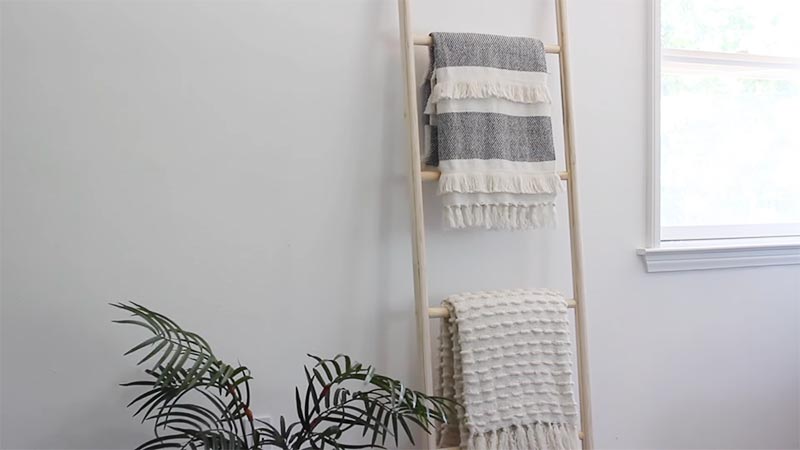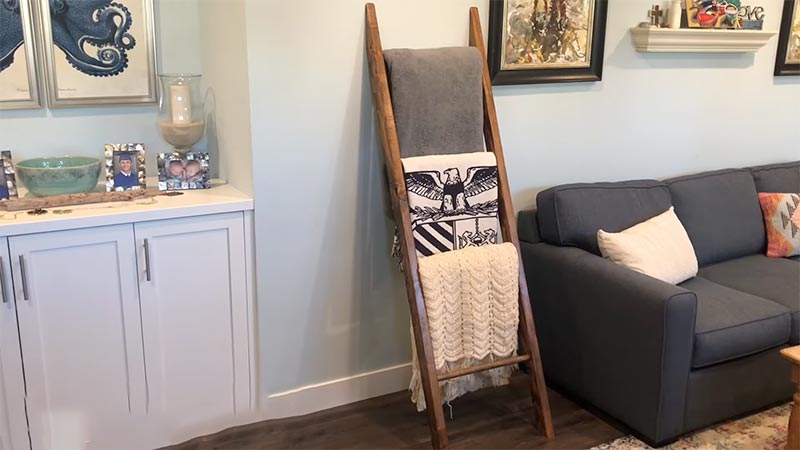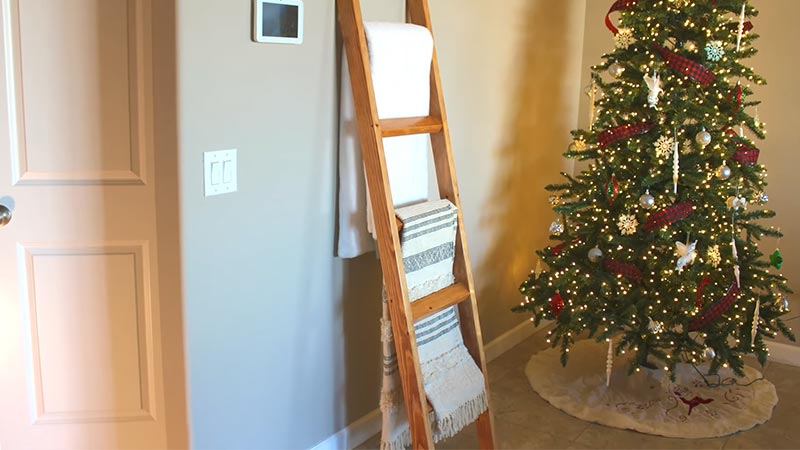The art of folding a quilt for display on a quilt ladder is a process that marries practicality with aesthetics. This skill allows you to showcase your cherished quilts in a way that preserves their beauty and celebrates their intricate design.
The method of folding and arranging on the ladder can accentuate specific patterns or colors, adding an extra layer of visual appeal.
Beyond adornment, proper folding minimizes wrinkles and creases, ensuring your quilts maintain their integrity over time.
This guide delves into the steps and considerations, empowering you to transform your quilt ladder into a canvas that beautifully exhibits the craftsmanship of these textile treasures.

What Is a Quilt Ladder?
A quilt ladder is a decorative and functional piece of furniture designed to display quilts or blankets. It typically features a tall, vertical structure with evenly spaced rungs or steps that serve as platforms for draping quilts.
Quilt ladders come in various designs and materials, including wood, metal, or a combination of both. They are often crafted with aesthetic details to complement different interior styles.
Unlike traditional quilt racks or wall-mounted displays, quilt ladders allow for simultaneous easy rotation and showcasing of multiple quilts.
This makes them popular for those who take pride in their quilting creations and want to exhibit them as part of their home decor. Quilt ladders add a touch of warmth and artistry to living spaces, creating a visually appealing focal point.
How to Fold a Quilt for a Quilt Ladder?
Folding a quilt for display on a quilt ladder is a wonderful way to showcase your handcrafted masterpiece.
It adds a touch of warmth and color to your living space and allows you to appreciate the artistry and effort that went into creating the quilt.
Here’s a step-by-step guide on how to fold a quilt for a quilt ladder:
Materials Needed:
- Quilt ladder
- Clean, well-pressed quilt
Steps:
Select a Clean Surface
Begin by choosing a clean, flat surface that comfortably accommodates the entire quilt.
This might be your bed with fresh, clean sheets, a clean and spacious floor covered with a sheet or a muslin fabric, or even a large, tidy table.
Smooth Out the Quilt
Lay the quilt out on the selected surface with great care. Starting from the center and moving outward, use your hands to smooth out any wrinkles or folds gently.
Pay special attention to the edges and corners, ensuring they lie flat. This meticulous step ensures that the quilt is presented in its most appealing state.
Fold in Half
With a deliberate yet gentle motion, fold the quilt in half vertically. This involves bringing one edge over to meet the other, ensuring the corners and edges align perfectly.
The top edge should be precisely parallel to the bottom edge. If your quilt features a distinctive pattern or design, ensure it lines up evenly along the fold for a polished appearance.
Fold in Half Again
For the second fold, match the edges with precision. The top and bottom edges should align seamlessly, resulting in a more compact, manageable rectangle. This step reduces the quilt’s size, making it easier to place on the quilt ladder.
Adjust as Necessary
Take a moment to inspect the quilt for any potential wrinkles or folds that may have formed during the folding process.
Gently smooth them out with your hands, being mindful of any delicate or embellished areas on the quilt. This step ensures that the quilt is presented flawlessly.
Final Fold
Depending on the dimensions of your quilt ladder, assess whether an additional fold is required.
This could involve folding the quilt in thirds or quarters to ensure it fits securely and doesn’t drape too low on the ladder’s rungs.
Place on the Quilt Ladder
Handle the folded quilt carefully, ensuring its weight is evenly supported. Position it delicately on the chosen rung of the quilt ladder.
Be attentive to rough edges or splinters that could snag the fabric. Gently drape the quilt over the rung, ensuring it hangs evenly and is centered.
Adjust for Display
Stepping back, take a moment to appreciate how the quilt hangs on the ladder. Make any necessary adjustments to ensure it’s displayed evenly and centered.
When it doesn’t quite meet your satisfaction, don’t hesitate to unfold and refold the quilt or reposition it on the ladder until you achieve the desired display.
Alternative Folding Methods for Quilt Ladders

While the traditional vertical fold is a classic method for displaying quilts on a ladder, there are other creative folding techniques that can add a unique flair to your quilt presentation.
Let’s explore some inventive folding approaches that can bring a fresh perspective to your quilt ladder display:
Diagonal Fold
This folding technique involves folding the quilt diagonally from one corner to the opposite corner, resulting in a triangular shape.
When draped over the ladder rungs with the folded corner at the top, it showcases the quilt’s design and emphasizes its three-dimensional texture and craftsmanship.
Fan Fold
Fold the quilt in a zigzag or accordion-style pattern to achieve a fan-like arrangement. The resulting folds create a graceful fan shape.
When draped over the ladder rungs with the fan formation at the top, this method adds an element of artistic flair and visual intrigue to your display.
Layered Fold
Fold the quilt into thirds or quarters, and then carefully drape it over the ladder rungs, with each layer slightly staggered.
This approach creates a captivating layered effect, allowing different portions of the quilt to be visible at once. It’s an excellent way to showcase intricate patterns and designs.
Zigzag Fold
Create a series of small, accordion-style folds by zigzagging the quilt.
When placed over the ladder rungs with the zigzag shape at the top, this method introduces visual interest and highlights the quilt’s unique design elements, making it a striking focal point in your space.
Roll and Drape
Instead of folding, tightly roll the quilt before draping it over the ladder rungs.
This method is particularly effective for quilts with intricate patterns or borders, as it allows the entire design to be showcased dynamically and visually appealingly.
Twisted Fold
Add a captivating twist to the display by folding the quilt diagonally and then giving it a slight twist before draping it over the ladder rungs.
This method introduces an artistic and visually engaging element to your quilt presentation, making it a true standout piece in your decor.
Benefits of Using a Quilt Ladder to Display Your Quilts

Using a quilt ladder to display your quilts offers a range of benefits that enhance your living space’s aesthetic and functional aspects.
Here are some key advantages:
Visual Appeal
Quilt ladders serve as stylish and eye-catching display pieces. They add a touch of rustic charm or modern elegance, depending on the design, enhancing the overall decor of your room.
Efficient Use of Space
Quilt ladders are vertical structures, making them space-efficient. They take up minimal floor space while providing ample room for displaying multiple quilts or blankets.
Easy Access and Rotation
Unlike quilt racks or wall-mounted displays, quilt ladders allow for easy access to your quilts.
This facilitates convenient rotation, letting you change the displayed quilts to suit different seasons, occasions, or moods.
Preserves Quilts’ Integrity
By draping quilts over ladder rungs, you avoid the need for folding, which can lead to creases and wear over time.
This display method helps maintain the quilts’ structural integrity and prevents potential damage from excessive folding.
Showcases Quilt Detailing
Quilts are fully visible from top to bottom when hung on a ladder. This enables guests and family members to appreciate your quilts’ intricate details, patterns, and craftsmanship.
Encourages Regular Use
Having your quilts on display encourages you to use and enjoy them more frequently.
Rather than being tucked away in storage, your quilts become functional pieces of art that add warmth and comfort to your living space.
Convenient Storage Solution
Quilt ladders can also serve as a storage solution. When not displaying quilts, you can drape throws, towels, or other linens over the rungs, keeping them within easy reach while maintaining an organized and tidy appearance.
Creates a Focal Point
A well-chosen quilt ladder can serve as a focal point in a room. Its height and unique design draw attention, making it a conversation starter and a central element in your decor.
Allows for Personal Expression
Selecting a quilt ladder that complements your personal style allows you to express your taste and preferences. Whether you opt for a rustic wooden ladder or a sleek, modern design, it extends your decorating choices.
Preserves Quilts’ Historical Significance
Displaying quilts on a ladder can be a way to honor the historical and cultural significance of these handmade creations. It allows you to showcase the artistry and craftsmanship of quilts, preserving their legacy for generations to come.
Care for Quilts on a Quilt Ladder

Caring for quilts displayed on a quilt ladder is crucial to preserve their beauty and integrity.
Here are some steps to ensure your quilts stay in excellent condition:
Regular Dusting
Use a soft, clean cloth or a duster with gentle bristles to regularly dust the quilt ladder and quilts. Pay special attention to the rungs and any decorative elements.
This prevents the buildup of dirt and dust, which can lead to discoloration and deterioration over time.
Rotate Quilts
Change the quilts displayed on the ladder periodically. This offers a fresh look to your space and helps distribute any light exposure more evenly.
Doing so minimizes the risk of one quilt fading more than others due to prolonged sunlight exposure.
Avoid Direct Sunlight
Ensure the quilt ladder is positioned away from direct sunlight. Prolonged exposure to UV rays can lead to fading and weakening of the fabric.
When relocating the ladder isn’t possible, consider using curtains, blinds, or UV-protective film on nearby windows to regulate light.
Control Humidity
Maintain a stable humidity level in the room where the quilt ladder is located. Fluctuations in humidity can cause quilts to expand and contract, potentially leading to stress on the fibers.
Use a dehumidifier or humidifier to achieve a consistent level, especially in environments prone to extreme changes.
Inspect for Pests
Regularly check for signs of pests like moths, beetles, or mice in the area around the quilt ladder. Store unused quilts in airtight containers and periodically inspect them for any signs of pests.
To deter insects, consider using natural pest repellents like lavender sachets or cedar blocks.
Avoid Heavy Handling
When taking a quilt down from the ladder, support its weight evenly to avoid stress on the seams or delicate areas.
Avoid unnecessary handling to prevent wear and tear. If possible, enlist help to ensure safe and careful handling.
Clean Environment
Keep the surroundings of the quilt ladder clean and free from potential contaminants.
Avoid placing it near areas where smoking occurs or in spaces where food is prepared. This helps prevent the absorption of odors or particles that could affect the quilts.
Use Protective Coverings
When you anticipate extended periods where the quilts won’t be displayed, consider covering them with clean, breathable fabric like muslin or a cotton sheet.
This protective layer helps shield the quilts from dust while still allowing air circulation.
Professional Cleaning
Consult a professional textile conservator when a quilt becomes noticeably soiled or stained.
They can provide expert advice on proper cleaning methods and, if necessary, perform professional cleaning or restoration services.
Address Spills Promptly
In the event of a spill, act promptly. Use a clean, white cloth to blot the affected area gently.
Avoid rubbing or scrubbing, as this can spread the stain. Seek professional advice for more stubborn or delicate stains.
FAQS
Can I fold a quilt in a way that highlights specific design elements?
Absolutely! You can experiment with different folding methods to showcase specific patterns or colors on your quilt.
Are there special considerations for antique or delicate quilts when folding them for a quilt ladder?
For delicate or antique quilts, consider using acid-free tissue paper to cushion folds and minimize direct contact with the ladder.
How do I prevent wrinkles or creases when folding a quilt for a quilt ladder?
To minimize wrinkles, ensure your quilt is clean and well-pressed before folding.
Can I switch out the folded quilt on my ladder frequently, or should I maintain the same display for an extended period?
You can absolutely switch out quilts on your ladder as often as you’d like. In fact, rotating your quilts allows you to enjoy and appreciate different pieces while also preventing overexposure to light.
When using a quilt ladder, are there specific folding techniques for larger or king-sized quilts?
Larger quilts may require additional folding steps. Consider folding them in thirds or quarters to fit the ladder’s dimensions, ensuring they hang securely without draping too low.
To Recap
Folding a quilt for display on a quilt ladder is an art that combines practicality with aesthetics. By following careful steps, you can showcase your cherished quilts in a way that preserves their beauty and craftsmanship.
The choice of folding method and the placement on the ladder allow you to highlight specific design elements, ensuring each quilt receives the attention it deserves.
Regular maintenance and handling with care are also essential to prolong their lifespan.
Ultimately, this process transforms a quilt ladder into a functional piece of art, adding warmth and character to your living space while honoring the time and effort invested in creating these cherished textile treasures
Leave a Reply